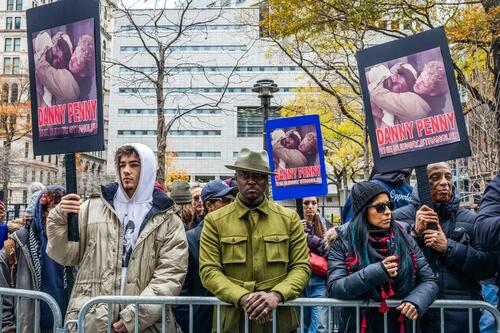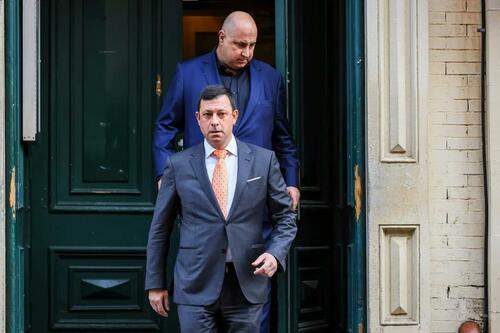
How The Daniel Penny Trial Divided The Nation
Authored by Michael Washburn via The Epoch Times (emphasis ours),
The trial of Daniel Penny split many observers into two camps—one passionately for and the other fiercely against the defendant, who restrained Jordan Neely in a chokehold on a New York subway in May 2023 and Neely died.
 Illustration by The Epoch Times, Getty Images
Illustration by The Epoch Times, Getty ImagesThe first camp brands Penny, who was acquitted of the charges of second-degree manslaughter and criminally negligent homicide, a brave hero who was protecting others from Neely. They say Penny is a victim of overreach by Manhattan District Attorney Alvin Bragg.
The second camp calls Penny a killer with no regard for the value of a poor, ill, homeless man’s life.
Representative of the view showing disdain for Penny were public comments made by Rep. Alexandria Ocasio-Cortez (D-N.Y.), whose district includes part of Queens. Before the trial began, she called him a “murderer,” and after the verdict, she criticized him again, saying Penny “does not have remorse about taking another person’s life.”
Defense lawyers, who unsuccessfully moved for a mistrial, complained to Judge Maxwell Wiley about the “circus-like” atmosphere fostered by loud, angry, sometimes menacing protesters on the street outside the courthouse.
Protesters had made threats against their client and against jurors if they didn’t vote to convict, defense lawyer Thomas Kenniff told the judge.
The trial began in late October and ended with Penny’s acquittal on Dec. 9. Despite the acquittal, the case raises questions about the challenge of holding a fair and impartial trial in an age of 24/7 social media saturation.
David Dorfman, a professor of law at Pace University in New York City, said he believes the “toxic social media environment” and the politicization of the justice system made it difficult to have a fair trial, in a case that the government never should have brought in the first place.
Divine Pryor, executive director of the Center for NuLeadership on Urban Solutions, said he doesn’t think the 24/7 coverage of the Penny case or the street protests exerted undue influence on the course of the trial or the outcome.
“There are always non-evidentiary pressures that emerge during any high-profile trial that come from arenas outside the judicial process, and they are usually shaped and guided by the media,” he said. His organization, a New York-based nonprofit, advocates for criminal justice reform.
 Jordan Neely’s uncle, Christopher Neely (C), joins demonstrators before Daniel Penny arrives for jury deliberations, outside the Manhattan Criminal Courthouse in New York City on Dec. 9, 2024. Alex Kent/Getty Images
Jordan Neely’s uncle, Christopher Neely (C), joins demonstrators before Daniel Penny arrives for jury deliberations, outside the Manhattan Criminal Courthouse in New York City on Dec. 9, 2024. Alex Kent/Getty Images“Unfortunately, I was not surprised by the verdict, and I did not expect a conviction on any of the charges, because he was immediately portrayed as a ‘war hero’ who was, once again, protecting the community,” Pryor said in an email to The Epoch Times.
“He was able to make bail and obtain legal counsel, and he won the hearts of the public. The fact that he was a middle-class, white male—well, what’s understood needs no explanation,” he said.
Pryor said he views the Penny case as similar in some ways to the Bernhard Goetz case in the ‘80s. Goetz shot and injured four young black men who he believed were trying to rob him on a subway in December 1984. In that case, public perceptions of crime, and the races of the people involved, may have shaped perceptions even before the case went to trial, Pryor suggested. The jury ultimately convicted Goetz of carrying an unlicensed firearm but acquitted him of attempted murder.
As a defense lawyer, Kenniff saw it differently. He sees non-evidentiary pressures as a negative influence not just in this trial, but in a politicized justice system more generally.
“There were certainly efforts to malign our client and poison the jury pool against him. I think Steven Raiser and I were successful in beating back against much of that, but I can’t say it didn’t impact things,” Kenniff said in an email to The Epoch Times.
Intimidation of jurors from activists and protesters demanding a certain outcome presents a “real risk,” he said.
“We saw attempts at that in this trial, where witnesses admitted they were afraid to testify favorably towards Mr. Penny out of fear of retribution. However, the jury refused to be swayed by any of that, and for that we’re grateful,” Kenniff stated.
Harvey Kushner, chair of the criminal justice department at Long Island University, said the social media-driven pressures that moved Penny’s defense lawyers to argue for a mistrial may be all the more severe in years to come.
“If you look at the Penny case, you can’t compare it to other times, because the media have changed so dramatically,” Kushner said.
“This was all over the media, people were not only viewing it but interacting with it on Facebook, TikTok, and X. The way they process it is different today.”
 Thomas Kenniff, attorney representing Daniel Penny, prepares to speak to the media after Penny turned himself into the 5th Precinct in New York City on May 12, 2023. Michael M. Santiago/Getty Images
Thomas Kenniff, attorney representing Daniel Penny, prepares to speak to the media after Penny turned himself into the 5th Precinct in New York City on May 12, 2023. Michael M. Santiago/Getty ImagesA Fateful Ride
In making its case to the jury, the defense evoked a situation that some or all of the twelve men and women could identify with, having rode the subway themselves and having found themselves in vulnerable situations where no police officers were on hand to respond in the event of an immediate physical threat.
The incident that defense lawyers Steven Raiser and Thomas Kenniff and lead prosecutor, Assistant District Attorney Dafna Yoran, debated in a lower Manhattan courtroom began on May 1, 2023, when an uptown F train pulled into the Second Avenue station.
Before the doors closed, Neely entered the train and immediately began acting in a manner that frightened and alarmed passengers, according to several who took the stand during the trial.
Neely, who had a record of 42 arrests and an outstanding warrant for his arrest on an assault charge at the time, threw his jacket onto the ground and began shouting that he was hungry, homeless, and did not care whether he went back to prison on Rikers Island.
That was when Penny, who had been listening to music on his earbuds, asked a stranger to hold the earbuds, and then got up, moved behind Neely, and applied a chokehold he had learned during his time in the U.S. Marines.
Direct and cross-examination dwelled extensively on the amount of time that Penny restrained Neely and on the physical and physiological factors that caused Neely’s death a short time later.
Nonetheless, witness after witness reiterated the sheer terror that Neely’s conduct caused them.
Though called to the stand as government witnesses, these men and women of diverse professional, personal, and ethnic backgrounds gave a version of events that could only buttress the defense position that passengers on the F train had a reasonable and immediate fear for their physical safety.
Lori Sitro, a research director at an agency in the city, described feeling particularly vulnerable because she had her small boy with her on the train. Under direct examination from a prosecutor, Sitro said that Neely’s threats were explicit, and frightening.
“He was shouting in people’s faces, ‘I don’t have water, I don’t have food, I don’t have a home, I want to hurt people, I want to go to Rikers, I want to go to prison.’ And he was getting increasingly belligerent,” Sitro recalled.
 Police stand outside the Broadway-Lafayette subway station a week after Jordan Neely died, in New York City on May 10, 2023. Spencer Platt/Getty Images
Police stand outside the Broadway-Lafayette subway station a week after Jordan Neely died, in New York City on May 10, 2023. Spencer Platt/Getty ImagesFrom the witness stand, Sitro performed a brief pantomime of lunges that she said Neely made toward passengers on the train. His conduct made her so fearful for the safety of her son, that she moved a stroller in front of him as an impromptu shield.
Another passenger, a teenaged student named Yvette Rosario, recalled feeling such terror that she thought she would pass out, and burying her face in the chest of a friend who stood next to her.
Dan Couvreur, the founder of a financial startup, said the incident far surpassed tense, unpleasant things he had witnessed on the subway before. “The anger, the aggressiveness, and that tone set it above these other situations that I’ve seen,” he said.
Yet another witness, Alethea Gittings, who was on her way to a dentist’s appointment when the trouble started, attributed a highly explicit threat to Neely. “If I remember correctly, he said ‘I don’t give a damn, I’ll kill a [expletive], I’m ready to die,’” she testified.
Gittings further testified not only to thanking Penny for his actions, but to agreeing, without any pressure on Penny’s part, to speak to police about what had happened.
The defense made much of the accounts of these men and women, who suddenly found themselves in a tense and terrifying situation and in need of someone to come to their aid.
Read the rest here…
Tyler Durden
Wed, 12/25/2024 – 12:00












